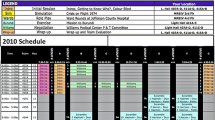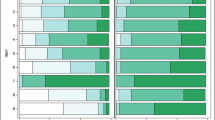Abstract
When uncertain, medical trainees often seek to co-regulate their learning with supervisors and peers. Evidence suggests they may enact self-regulated learning (SRL) strategies differently when engaged in self- versus co-regulated learning (Co-RL). We compared the impacts of SRL and Co-RL on trainees’ acquisition, retention, and preparation for future learning (PFL) of cardiac auscultation skills during simulation-based training. In our two-arm, prospective, non-inferiority trial, we randomly assigned first- and second-year medical students to the SRL (N = 16) or Co-RL conditions (N = 16). Across two learning sessions separated by two-weeks, participants practiced and were assessed in diagnosing simulated cardiac murmurs. We examined diagnostic accuracy and learning trace data across sessions, and conducted semi-structured interviews to explore participants’ understandings of their underlying choices and learning strategies. SRL participants’ outcomes were non-inferior to Co-RL participants on the immediate post-test and retention test, but not on the PFL assessment (i.e., inconclusive). Analyzing interview transcripts (N = 31) generated three themes: perceived utility of initial learning supports for future learning; SRL strategies and sequencing of murmurs; and perceived control over learning across sessions. Co-RL participants regularly described relinquishing control of learning to supervisors and regaining it when on their own. For some trainees, Co-RL seemed to interfere with their situated and future SRL. We posit that transient clinical training sessions, typical in simulation-based and workplace-based settings, may not allow the ideal processes of Co-RL to unfold between supervisor and trainee. Future research must examine how supervisors and trainees can share accountability to develop the shared mental models that underlie effective Co-RL.


Similar content being viewed by others
References
Allal, L. (2020). Assessment and the co-regulation of learning in the classroom. Assessment in Education: Principles, Policy & Practice, 27(4), 332–349. https://doi.org/10.1080/0969594x.2019.1609411
Bernacki, M. L. (2017). Examining the cyclical, loosely sequenced, and contingent features of self-regulated learning: Trace data and their analysis. In D. H. Schunk & J. A. Greene (Eds.), Handbook of self-regulation of learning and performance (pp. 370–387). Routledge.
Bjork, R. A., Dunlosky, J., & Kornell, N. (2013). Self-regulated learning: Beliefs, techniques, and illusions. Annual Review of Psychology, 64, 417–444. https://doi.org/10.1146/annurev-psych-113011-143823
Boekaerts, M. (1999). Self-regulated learning: Where we are today. International Journal of Educational Research, 31, 445–457.
Bransen, D., Govaerts, M. J. B., Panadero, E., Sluijsmans, D. M. A., & Driessen, E. W. (2022a). Putting self-regulated learning in context: Integrating self-, co-, and socially shared regulation of learning. Medical Education, 56(1), 29–36. https://doi.org/10.1111/medu.14566
Bransen, D., Govaerts, M. J. B., Sluijsmans, D. M. A., Donkers, J., van den Bossche, P. G. C., & Driessen, E. W. (2022b). Relationships between medical students’ co-regulatory network characteristics and self-regulated learning: A social network study. Perspectives on Medical Education, 11(1), 28–35. https://doi.org/10.1007/s40037-021-00664-x
Bransen, D., Govaerts, M. J. B., Sluijsmans, D. M. A., & Driessen, E. W. (2020). Beyond the self: The role of co-regulation in medical students’ self-regulated learning. Medical Education, 54(3), 234–241. https://doi.org/10.1111/medu.14018
Bransford, J. D., & Schwartz, D. L. (1999). Rethinking transfer: A simple proposal with multiple implications. In A. Iran-Nejad & P. D. Pearson (Eds.), Review of research in education (Vol. 24, pp. 61–101). American Educational Research Association.
Brydges, R., Fiume, A., & Grierson, L. (2022a). Mastery versus invention learning: Impacts on future learning of simulated procedural skills. Advances in Health Sciences Education, 27(2), 441–456.
Brydges, R., Law, M., Ma, I. W., & Gavarkovs, A. (2022b). On embedding assessments of self-regulated learning into licensure activities in the health professions: A call to action. Canadian Medical Education Journal, 13(4), 100–109.
Brydges, R., Manzone, J., Shanks, D., Hatala, R., Hamstra, S. J., Zendejas, B., & Cook, D. A. (2015). Self-regulated learning in simulation-based training: A systematic review and meta-analysis. Medical Education, 49(4), 368–378. https://doi.org/10.1111/medu.12649
Brydges, R., Peets, A., Issenberg, S. B., & Regehr, G. (2013). Divergence in student and educator conceptual structures during auscultation training. Medical Education, 47(2), 198–209. https://doi.org/10.1111/medu.12088
Brydges, R., Tran, J., Goffi, A., Lee, C., Miller, D., & Mylopoulos, M. (2020). Resident learning trajectories in the workplace: A self-regulated learning analysis. Medical Education, 54(12), 1120–1128. https://doi.org/10.1111/medu.14288
Butler, D. L., & Cartier, S. C. (2004). Learning in varying activities: An explanatory framework and a new evaluation tool founded on a model of self-regulated learning.
Butler, D. L., & Cartier, S. C. (2017). Advancing research and practice about self-regulated learning: The promise of in-depth case study methodologies. In D. H. Schunk & J. A. Greene (Eds.), Handbook of self-regulation of learning and performance (pp. 352–369). Routledge.
Cepeda, N. J., Pashler, H., Vul, E., Wixted, J. T., & Rohrer, D. (2006). Distributed practice in verbal recall tasks: A review and quantitative synthesis. Psychological Bulletin, 132(3), 354.
Cleary, T. J., Durning, S. J., & Artino, A. R. (2016). Microanalytic assessment of self-regulated learning during clinical reasoning tasks: Recent developments and next steps. Academic Medicine, 91(11), 1516–1521. https://doi.org/10.1097/ACM.0000000000001228
Cristancho, S. M., Apramian, T., Vanstone, M., Lingard, L., Ott, M., & Novick, R. J. (2013). Understanding clinical uncertainty: What is going on when experienced surgeons are not sure what to do? Academic Medicine, 88(10), 1516–1521. https://doi.org/10.1097/ACM.0b013e3182a3116f
Dubrowski, A., Backstein, D., Abughaduma, R., Leidl, D., & Carnahan, H. (2005). The influence of practice schedules in the learning of a complex bone-plating surgical task. American Journal of Surgery, 190(3), 359–363. https://doi.org/10.1016/j.amjsurg.2005.03.027
Duffy, M. C., Lajoie, S., & Lachapelle, K. (2016). Measuring emotions in medical education: Methodological and technological advances within authentic medical learning environments. In S. Bridges, L. K. Chan, & C. E. Hmelo-Silver (Eds.), Educational technologies in medical and health sciences education (pp. 181–213). Springer.
Gandomkar, R., Yazdani, K., Fata, L., Mehrdad, R., Mirzazadeh, A., Jalili, M., & Sandars, J. (2020). Using multiple self-regulated learning measures to understand medical students’ biomedical science learning. Medical Education, 54(8), 727–737.
Hadwin, A. F., Nesbit, J. C., Jamieson-Noel, D., Code, J., & Winne, P. H. (2007). Examining trace data to explore self-regulated learning. Metacognition and Learning, 2(2–3), 107–124. https://doi.org/10.1007/s11409-007-9016-7
Hadwin, A., Järvelä, S., & Miller, M. (2017). Self-regulation, co-regulation, and shared regulation in collaborative learning environments. In D. H. Schunk & J. A. Greene (Eds.), Handbook of self-regulation of learning and performance (pp. 83–106). Routledge.
Heritage, M. (2016). Assessment for learning: Co-regulation in and as student–teacher interaction. In D. Laveault & L. Allal (Eds.), Assessment for learning: Meeting the challenge of implementation (Vol. 4, pp. 311–326). Springer.
Ilgen, J. S., Eva, K. W., de Bruin, A., Cook, D. A., & Regehr, G. (2019). Comfort with uncertainty: Reframing our conceptions of how clinicians navigate complex clinical situations. Advances in Health Sciences Education, 24(4), 797–809. https://doi.org/10.1007/s10459-018-9859-5
Lane DM. Confidence Interval on the Difference Between Means [Internet]. [cited 2020 Dec 11]. http://onlinestatbook.com/2/estimation/difference_means.html. (n.d.).
LeBlanc, V., & Posner, G. (2022). Emotions in simulation-based education: Friends or foes of learning? Advances in Simulation, 7(1), 1–8.
Manzone, J. C., Mylopoulos, M., Ringsted, C., & Brydges, R. (2021). How supervision and educational supports impact medical students’ preparation for future learning of endotracheal intubation skills: A non-inferiority experimental trial. BMC Medical Education. https://doi.org/10.1186/s12909-021-02514-0
Martin, L., & Schwartz, D. L. (2009). Prospective adaptation in the use of external representations. Cognition and Instruction, 27(4), 370–400. https://doi.org/10.1080/07370000903221775
Mylopoulos, M., Brydges, R., Woods, N. N., Manzone, J., & Schwartz, D. L. (2016). Preparation for future learning: A missing competency in health professions education? Medical Education, 50(1), 115–123. https://doi.org/10.1111/medu.12893
Ng, S. L., Kangasjarvi, E., Lorello, G. R., Nemoy, L., & Brydges, R. (2019). ‘There shouldn’t be anything wrong with not knowing’: Epistemologies in simulation. Medical Education, 53(10), 1049–1059. https://doi.org/10.1111/medu.13928
Panadero, E., & Järvelä, S. (2015). Socially shared regulation of learning: A review. European Psychologist, 20(3), 190–203. https://doi.org/10.1027/1016-9040/a000226
Pintrich, P. R. (2000). The role of goal orientation in self-regulated learning. In M. Boekaerts, P. Pintrich, & M. Zeidner (Eds.), Handbook of self regulation (pp. 452–502). Academic Press.
Rich, J. V. (2017). Proposing a model of co-regulated learning for graduate medical education. Academic Medicine, 92(8), 1100–1104. https://doi.org/10.1097/ACM.0000000000001583
Roll, I., & Winne, P. (2015). Understanding, evaluating, and supporting self-regulated learning using learning analytics. Journal of Learning Analytics, 2(1), 7–12.
Sagasser, M. H., Kramer, A. W. M., Fluit, C. R. M. G., van Weel, C., & van der Vleuten, C. P. M. (2017). Self-entrustment: How trainees’ self-regulated learning supports participation in the workplace. Advances in Health Sciences Education, 22(4), 931–949. https://doi.org/10.1007/s10459-016-9723-4
Sagasser, M. H., Kramer, A. W. M., van Weel, C., & van der Vleuten, C. P. M. (2015). GP supervisors’ experience in supporting self-regulated learning: A balancing act. Advances in Health Sciences Education, 20(3), 727–744. https://doi.org/10.1007/s10459-014-9561-1
Schmidt, R. A., & Bjork, R. A. (1992). New conceptualizations of practice: Common principles in three paradigms suggest new concepts for training. Psychological Science, 3(4), 207–218.
Schnellert, L. M., Butler, D. L., & Higginson, S. K. (2008). Co-constructors of data, co-constructors of meaning: Teacher professional development in an age of accountability. Teaching and Teacher Education, 24(3), 725–750. https://doi.org/10.1016/j.tate.2007.04.001
Sealed Envelope Ltd. Power calculator for continuous outcome non-inferiority trial. 2012 [cited 2020 Dec 11]. https://www.sealedenvelope.com/power/continuous-noninferior. (n.d.).
Soderstrom, N. C., & Bjork, R. A. (2015). Learning versus performance: An integrative review. Perspectives on Psychological Science, 10(2), 176–199. https://doi.org/10.1177/1745691615569000
Steenhof, N., Woods, N. N., van Gerven, P. W. M., & Mylopoulos, M. (2019). Productive failure as an instructional approach to promote future learning. Advances in Health Sciences Education, 24(4), 739–749. https://doi.org/10.1007/s10459-019-09895-4
Thompson Burdine, J., Thorne, S., & Sandhu, G. (2021). Interpretive description: A flexible qualitative methodology for medical education research. Medical Education, 55(3), 336–343. https://doi.org/10.1111/medu.14380
Thorne, S., Kirkham, S. R., & Macdonald-Emes, J. (1997). Interpretive description: A noncategorical qualitative alternative for developing nursing knowledge. Research in Nursing & Health, 20, 169–177.
Walker, E., & Nowacki, A. S. (2011). Understanding equivalence and noninferiority testing. Journal of General Internal Medicine, 26(2), 192–196. https://doi.org/10.1007/s11606-010-1513-8
Welink, L. S., van Charldorp, T. C., di Colandrea, L., Bartelink, M. L. L., Pype, P., Damoiseaux, R. A. M. J., & de Groot, E. (2021). Bidirectional learning opportunities: How GP-supervisors and trainees exchange knowledge. Medical Education, 55(12), 1407–1418. https://doi.org/10.1111/medu.14590
Winne, P. H., & Perry, N. E. (2000). Measuring self-regulated learning. In M. Boekaerts, P. Pintrich, & M. Zeidner (Eds.), Handbook of self-regulation (pp. 531–566). Academic Press.
Acknowledgements
The authors wish to thank the study participants, the University of Toronto, Temerty Faculty of Medicine MD Program, and Drs. Maria Mylopoulos and Carol-Anne Moulton for supporting this work. Dr. Lorello dedicates this work in acknowledgement of the late Dr. Brian Kavanagh for his support during his residency and Clinician-Investigator Program years.
Funding
Dr. Ryan Brydges is generously funded by the Professorship in Technology-Enabled Education, at St. Michael’s Hospital, Unity Health Toronto.
Author information
Authors and Affiliations
Contributions
GL and RB conceptualized this study. GL led in collecting the data. BI supported content development and simulator logistics. GL, KH, and RB analyzed and interpreted the data. GL, KH and RB drafted the paper and all authors critically reviewed it and approved the final version to be published.
Corresponding author
Ethics declarations
Conflict of interest
None.
Additional information
Publisher's Note
Springer Nature remains neutral with regard to jurisdictional claims in published maps and institutional affiliations.
Supplementary Information
Below is the link to the electronic supplementary material.
Rights and permissions
Springer Nature or its licensor (e.g. a society or other partner) holds exclusive rights to this article under a publishing agreement with the author(s) or other rightsholder(s); author self-archiving of the accepted manuscript version of this article is solely governed by the terms of such publishing agreement and applicable law.
About this article
Cite this article
Lorello, G.R., Hodwitz, K., Issenberg, S.B. et al. Relinquishing control? Supervisor co-regulation may disrupt students’ self-regulated learning during simulation-based training. Adv in Health Sci Educ 29, 9–25 (2024). https://doi.org/10.1007/s10459-023-10244-9
Received:
Accepted:
Published:
Issue Date:
DOI: https://doi.org/10.1007/s10459-023-10244-9




